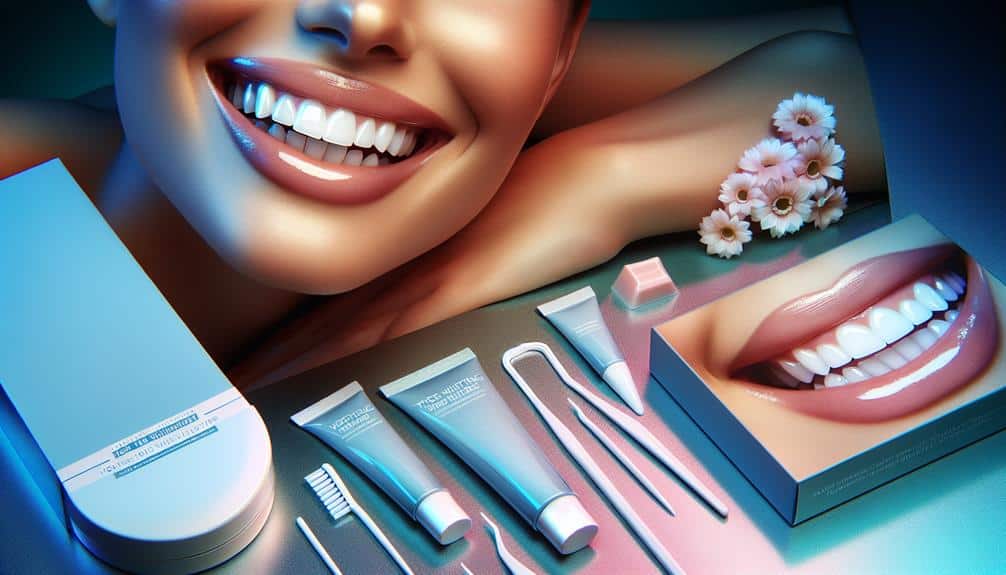To maximize the durability of your whitening strip results, carefully follow application directions and guarantee proper technique for best effectiveness. Starting with clean, dry teeth and positioning the strips correctly while gently pressing to secure them in place is essential. Implement post-treatment practices and make wise diet choices to avoid staining foods and beverages. Maintain excellent oral hygiene practices, schedule regular touch-ups, and use whitening toothpaste for lasting results. Remember, precise application and consistent aftercare practices are key to sustaining and enhancing your smile's vibrancy.
Key Points
- Follow post-treatment care guidelines for lasting effects.
- Choose foods and drinks carefully to prevent staining.
- Maintain consistent oral hygiene practices for longevity.
- Schedule touch-up treatments regularly for sustained results.
- Store and handle whitening strips correctly to preserve effectiveness.
Understanding Whitening Strip Application
To ensure excellent outcomes, carefully follow the directions for applying whitening strips to your teeth. Proper technique is essential for maximizing the effectiveness of whitening strips. Begin by ensuring your teeth are clean and dry before applying the strips. Position the strip over your teeth, ensuring it adheres properly to the surface. Gently press the strip to secure it in place, allowing the whitening agent to make full contact with your teeth.
Time intervals play a significant role in the whitening process. Most whitening strips require around 30 minutes per application. It's important to adhere to the recommended time frame to achieve the best results. Avoid leaving the strips on for longer periods than instructed, as this can lead to increased tooth sensitivity without providing additional benefits. Similarly, don't remove the strips too early, as this can result in incomplete whitening. Consistency in following the proper time intervals is key to successfully brightening your smile with whitening strips.
Tips for Prolonging Whitening Effects
For prolonged whitening effects, consider implementing specific post-treatment practices to maintain your brighter smile. Making wise diet choices and adopting beneficial lifestyle changes can greatly contribute to extending the effects of whitening treatments. Avoiding foods and beverages that are known to stain teeth, such as coffee, tea, red wine, and dark berries, can help preserve the whiteness of your smile. Additionally, incorporating crunchy fruits and vegetables like apples and carrots into your diet can act as natural teeth cleaners, reducing the buildup of stains.
Maintaining excellent oral hygiene practices is vital in extending the longevity of whitening effects. Brushing your teeth at least twice a day, flossing regularly, and using mouthwash can help prevent new stains from developing. Moreover, scheduling regular dental visits for professional cleanings and check-ups is essential for monitoring the health of your teeth and ensuring that your whitening results endure over time. By combining these lifestyle adjustments with proper oral care, you can maximize the durability of your whitening strip results.
Maintenance Practices for Lasting Results
Implementing consistent oral care routines and dietary habits is crucial to maintaining the lasting results of whitening treatments. To guarantee your whitening strip results stay vibrant for longer periods, follow these maintenance practices:
- Regular Touch Ups: Schedule periodic touch-up sessions as recommended by your dentist to sustain the brightness of your smile.
- Proper Aftercare: After each whitening session, refrain from consuming staining foods and beverages for at least 24 hours to allow the whitening effects to set in.
- Use Whitening Toothpaste: Integrate a whitening toothpaste into your daily oral hygiene routine to help prevent new stains from forming.
- Bi-Annual Dental Check-ups: Routine visits to the dentist can help monitor the condition of your teeth and suggest touch-ups or adjustments to your whitening routine as necessary.
Incorporating Whitening Strips Into Routine
Incorporate whitening strips into your daily oral care routine to enhance the vibrancy of your smile. Consistency is key when integrating whitening strips into your daily habits. Selecting the right product is crucial for best results. Look for whitening strips that are designed to stay in place and have a formulation that adheres well to teeth to guarantee even coverage and effective whitening.
To incorporate whitening strips effectively, start by choosing a specific time of day to use them consistently. This can be in the morning or evening, depending on your schedule. Make sure to brush and floss your teeth before applying the strips to ensure they stick properly and maximize contact with the teeth.
Additionally, consider the duration of use recommended by the product instructions. Overusing whitening strips can lead to sensitivity and damage to your enamel. Following the recommended guidelines for frequency and duration will help you achieve the desired results without compromising your oral health. Remember that incorporating whitening strips into your routine requires commitment and following best practices for product selection and application.
Factors Affecting Whitening Strip Longevity
Ensuring proper storage and handling of whitening strips can greatly impact their longevity and effectiveness. To maximize the durability of whitening strip results, consider the following factors:
- Diet Impact: Consuming foods and beverages that are known to stain teeth, such as coffee, tea, or red wine, can reduce the longevity of whitening strip results. Limiting the intake of these items can help maintain a whiter smile for longer periods.
- Lifestyle Habits: Habits like smoking or chewing tobacco can accelerate the discoloration of teeth, counteracting the effects of whitening strips. Avoiding these habits can contribute to the longevity of the whitening results.
- Critical Usage: Following the recommended usage instructions provided with the whitening strips is critical for achieving long-lasting results. Overusing or misusing the strips can lead to sensitivity and reduced effectiveness over time.
- Regular Maintenance: Maintaining good oral hygiene practices, such as brushing and flossing regularly, can help preserve the effects of whitening strips. Proper dental care can prevent new stains from forming and extend the longevity of the whitening treatment.
Frequently Asked Questions
Can Whitening Strips Be Used on Dental Work Such as Crowns or Veneers?
You can use whitening strips on dental work like crowns or veneers, but results may vary. The strips may not whiten these surfaces as well as natural teeth. Consider consulting a dentist for advice on compatibility, effectiveness, long-term impact, and safety.
Are There Any Specific Foods or Drinks That Should Be Avoided to Maintain Whitening Strip Results?
To maintain whitening strip results, avoid foods and drinks like coffee that can cause stains. Consider whitening strip alternatives for long-lasting effects. Practice good oral hygiene and be mindful of dietary impact on maintaining a bright smile.
How Often Should Whitening Strips Be Used to See the Best Results?
To achieve peak results and maintain longevity, use whitening strips consistently. Following the suggested frequency is key for effectiveness. Strips should be used as directed to guarantee proper maintenance and maximize the longevity of results.
Is It Safe to Use Whitening Strips for an Extended Period of Time?
Using whitening strips for a long time can pose safety concerns, like enamel damage or tooth sensitivity. Guarantee your oral health by consulting a dentist. Maintenance tips include regular check-ups and using alternatives like whitening toothpaste.
Can Whitening Strips Cause Sensitivity or Damage to the Teeth and Gums With Prolonged Use?
When using whitening strips for long periods, you risk tooth and gum sensitivity or damage. To prevent this, limit usage as directed, follow proper application techniques, and consult your dentist if issues arise.



